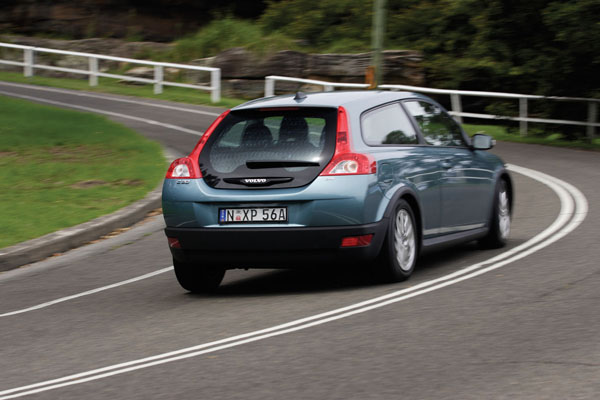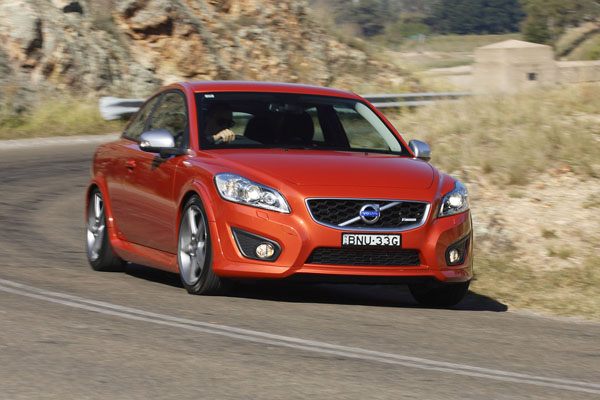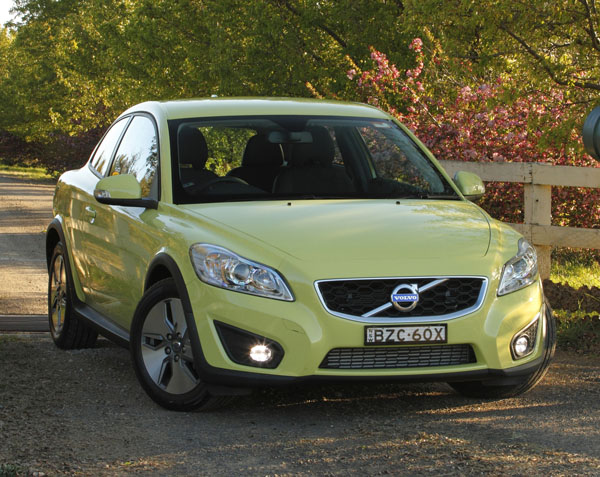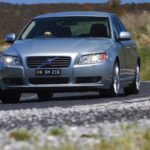Volvo C30 is a small coupe from the renowned Swedish car marque. Designed as part of its plan to get away from its ‘sensible but boring’ image it had styling that harked back to the P1800 of the 1960s and ‘70s .
The C30’s styling was polarising, particularly the large sloping back window, when introduced in March 2007, but found favour later and sales on the used-car market are strong these days.
There’s a fascinating model range, including a pretty quick T5 and an ultra-economy special.
The C30 may be a small coupe-wagon, but it has decent interior space for four adults. There’s plenty of front leg and headroom and reasonable rear legroom. The front seats are large and supportive. Tall rear passengers may find the sloping roof causing them inconvenience. Getting in and out of the back seats is easier than average.
Volvo’s ‘floating’ centre console is a nice cabin feature. Only about two centimetres thick it comes in different styles to suit individual owners. There’s handy stowage space behind this console, which is complemented by reasonably sized door pockets.
Luggage space is quite good, though very large suitcases may not fit. Smaller ones, as the day-to-day shopping will be carried with ease. A removable soft cover protects the boot’s contents from prying eyes. However, it’s very fiddly in use, perhaps try it for yourself as part of your pre-purchase checkout.
Ride comfort is generally good, though some tough bumps on Aussie back roads may challenge the C30. Handling has a near-neutral feel unless it’s pushed really hard. Some find the steering doesn’t have the sort of feedback they like. Volvo C30 probably leans more in the small wagon direction than pure coupe as part of its suspension compromise. The sporty T5 is an exception.
It goes without saying that the Volvo C30 is a very safe vehicle having many standard features back in 2007 that others only picked up years later.
A high-performance C30 T5 R-Design by the Polestar guys and gals can run 6.1-second zero to 100 numbers. Excellent for its day, but firmer suspension may not be to the taste of those looking for fashion before function.
Initially all Australian imports of the C30 offered a choice between two five-cylinder petrol engines. One is a naturally-aspirated 2.4-litre, the other a turbocharged 162 kW, 320 Nm 2.5-litre sporting unit. The smaller engine sits beside a five-speed manual, the sporting one has six ratios. Both had an optional five-speed automatic.
A 2.4-litre turbo-diesel, again with five cylinders, was introduced a few months after the petrol units. Turbo lag didn’t do a lot for the sporting feel, but once up and running there’s plenty of grunt.
Volvo C30 DRIVe, an ultra-economy model arrived in October 2010. Powered by a four-cylinder, 1.6-litre turbo-diesel engine it’s only fitted with a five-speed manual gearbox. First and second gears are the same as in the standard C30 models so performance off the line is fine, but the three higher gears are aimed at keeping revs as low as possible so you might have to do a fair bit of gearshifting at times. An interesting historical oddity, it’s possibly best left to the enthusiasts – those who are proud that in its day this Volvo had official fuel number lower than Toyota Prius.
Volvo C3 received a facelift inside and out early in 2010. At the same time the suspension was given a slightly more sporting tune and the engines received a mild rework.
Volvo has been solidly established in Australia for many decades and the dealer network is well organised. Naturally there are more dealers in metro areas than in the bush, but quite a few country cities and larger country towns do have official representation.
Quite a few aftermarket mechanical workshops specialise in European cars. Volvo is certainly no exception and quite a few factory trained Volvo mechanics are now in this field.
Spare parts prices for the Volvo C30 are about average for this class and we have heard of no major complaints about availability.
Insurance charges are reasonable for a midrange European marque. Some companies may charge extra for younger drivers getting into a high-performance T5 Polestar so check around before deciding to buy.
The C30 left the Australian market midway through 2013 and hasn’t really been replaced with a similar model. Probably because fuel-guzzling SUVs have taken the place of coupes in the popularity stakes.
WHAT TO LOOK FOR
The C30 is generally well built and reliable, but it’s a reasonably complex machine so we recommend having an expert check it out. Ideally at a Volvo dealership, but motoring association engineers are a pretty good alternative.
Check a manual gearbox doesn’t hang up during changes, the three-two downshift is the most likely to be the one that suffers first if the car has done a lot of work.
Do the fast de-clutch and re-clutch test without taking your foot of the accelerator. If there’s signs of any clutch slip either find another car, or get a discount on the price.
Automatics are generally fine, but if one is slow to change gears, or changes too often when not really necessary, have it professionally tested.
The engine should start promptly and idle smoothly virtually straight away. A diesel will be slower than a petrol to fire up, but too long a delay could mean troubles.
CAR BUYING TIP
Even cars with excellent reputations can fall into the hands of bad drivers. So always have a full inspection before handing over your hard-earned.














